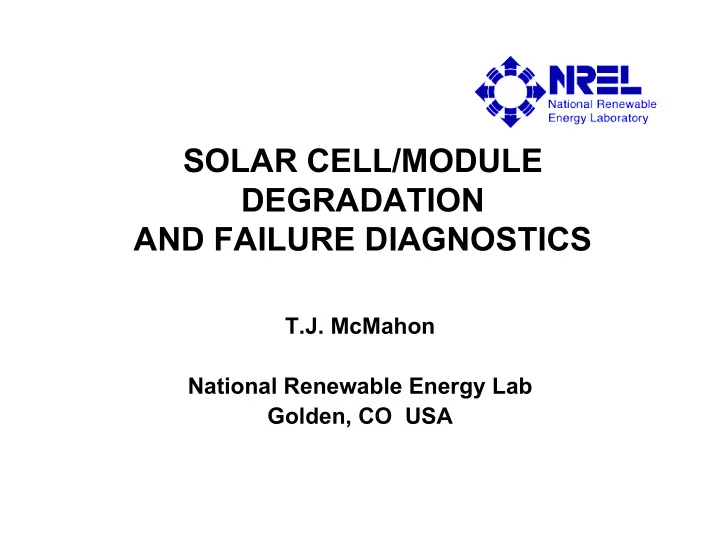

SOLAR CELL/MODULE DEGRADATION AND FAILURE DIAGNOSTICS T.J. McMahon National Renewable Energy Lab Golden, CO USA
Purpose • Review of solar cell/module degradation and failure diagnostic tools. • Coring technique to acquire samples and evaluate interface toughness. • Accelerated testing and failure mechanisms in PV. 2
Outline • Basic Module Types • Diagnostics • Distributed vs localised • Definition of reliability • Accelerated testing in PV • Failure mechanisms • Summary 3
Wafer Type Module i i + 1 Cell Interconnect 4
Thin-Film Type Module GLASS TCO TCO A-Si A-Si Al Cell Interconnect 5
Thermal Imaging, Forward Bias 0 y @ NREL 5 y @ NREL 6
Two-Terminal, Non-destructive Shunt Resistance Technique 5 y @ NREL 7 y @ NREL 25 25 R (ohms/Cell) R (ohms/Cell) 0 0 Cells 1 thru 48 Cells 1 thru 48 7
Two-Terminal, Non-destructive Shunt Resistance Technique H-series cells PV module Constant Calibrated Uniform So 1000 ohm Bias Light Produces 1 mV 8
CdTe cell Weak Diode: IR and IVs 4.5 - 6 % after stress. Hot in forward bias. Not in reverse bias 1225 h at Voc at 100 °C 0.025 0.02 NEDT 25 mK 0.015 0.01 I(A/cm 2 ) 0.005 0 -0.005 -0.01 -0.015 -0.02 -0.025 -0.2 0 0.2 0.4 0.6 0.8 1 V(volts) 9
Weak Diode Removal 1225 h at Voc at 100 °C WD @ Corner Removed 0.025 0.025 0.02 0.02 0.015 0.015 0.01 I(A/cm 2 ) 0.01 I(A/cm 2 ) 0.005 0.005 0 0 4.5 - 6 % -0.005 -0.005 -0.01 4.5 - 6 % -0.01 9 % -0.015 -0.015 -0.02 -0.02 -0.025 -0.025 -0.2 0 0.2 0.4 0.6 0.8 1 -0.2 0 0.2 0.4 0.6 0.8 1 V(volts) V(volts) 10
P-Spice circuit w/WD 4.5 - 6 % 0.025 0.02 0.015 0.01 I(A/cm 2 ) 0.005 0 -0.005 -0.01 -0.015 -0.02 -0.025 -0.2 0 0.2 0.4 0.6 0.8 1 V(volts) 11
P-Spice/AMPS (crossover/rollover) 0.025 0.02 9 % 0.015 0.01 I(A/cm 2 ) 0.005 0 -0.005 -0.01 -0.015 -0.02 -0.025 -0.2 0 0.2 0.4 0.6 0.8 1 V(volts) 12
Si Wafer Modules Cracked cell Shorted interconnect 13
Shear Strength Measurement at Front Cell/EVA Interface TPE Backsheet EVA Si Cell EVA Tempered Front Glass Si Cell EVA Tempered Front Glass 14
Torque-Twist-Toughness 0.5 0.4 Torque (N-m) 0.3 I 0.2 II III 0.1 0 0 10 20 30 40 Angle (°) 15
Outdoor/Chamber UV Toughness Aging of Si/EVA Interface 0.30 0.25 0.20 Toughness (J-rad) 0.15 0.10 0.05 Control UV Tubes XR-260 Outdoor OATS-1X OATS-3X 0.00 2 2 2 2 1568 MJ/m 2 Exposure Unexposed 1975 MJ/m 2900 MJ/m 1300 MJ/m 1750 MJ/m Conditions: 50-65 °C 45-60 °C 45-55 °C 45-70 °C 16
Failure Mechanisms (FMs) • Packaging vs Cell – Packaging is 90% of the field returns * ^ – 50% of the cost • Distributed vs Localised • General vs Technology Specific * Includes cell interconnects. ^ Failure rate and cause depend on how mature the technology is, e.g. BP Silicon is 1/4200 module year; Newbee modules are 1/10 - 1/100. 17
Service Life Prediction 18
FMs: Modules General Field returns and anticipated failures • Front Sheet/Encap failure • Cell/Encap failure • Back Sheet/Encap failure • Stress breakage of glass/glass laminate • Glass edge damage/breakage Corrosion of grid lines / ohmic contact / R series • • Poor solder joint(string ribbons and J-boxes) • By-pass diode failure • Frame/mounting failure • Failure of electrical safety/Hi-Pot isolation 19
FMs: Modules Technology Specific Field returns and anticipated failures Wafer Si: Crack formation in thinner cells • • Solder joint degradation on cells • Ribbon related open circuit or shunting Thin Film: Flexible packaging interconnect failure • Laser scribe interconnect failure • De-adhesion of device layers, inc. CTOs and metal contacts • Busbar adhesion and electrical contact • Weak diode or shunt defects • Decreasing ff (E-field collection or series resistance issues) • Moisture ingress problems, esp. flexible with CIS • Diffusion, esp. Cu in CdTe • Staebler-Wronski, esp. single junction a-Si • SnO 2 corrosion in superstrate cells • 20
Conclusions • Artificially accelerating environmental stress on PV cells and modules is used to test for their reliability under field conditions. • Failure diagnostic techniques are used to locate, identify, and evaluate resulting failure modes. • A new core torque-twist technique used to evaluate module packaging durability and obtain sample specimens for failure analysis is reviewed. • Proposed failure mechanisms for the different module technologies. 21
Recommend
More recommend